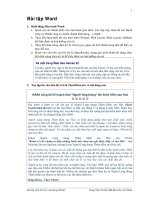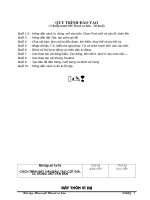Slide toàn tập microsoft word 2013 ch24
Bạn đang xem bản rút gọn của tài liệu. Xem và tải ngay bản đầy đủ của tài liệu tại đây (1.25 MB, 48 trang )
© Paradigm Publishing, Inc.
1
Objectives
Objectives
Chapter 24: Creating and Managing Styles
Performance Objectives
Apply Styles
Save a Custom Style Set
Create Styles
Change Default Settings
CHECKPOINT 1
Delete a Custom Style Set
Modify a Style
Create Multilevel List and Table Styles
Save Styles in a Template
Use the Style Inspector
Modify an Applied Style
Manage Styles
Display All Styles
CHECKPOINT 2
Reveal Style Formatting
© Paradigm Publishing, Inc.
2
Objectives
Objectives
Apply Styles
A style is a set of formatting instructions that you can apply to text.
Word provides a number of predesigned styles and groups styles that apply similar formatting into sets called
style sets.
Whereas a theme changes the overall colors, fonts, and effects used in a document, a style set changes how the
colors, fonts, and effects are combined and which color, font, and effect is dominant.
A variety of methods is available for applying styles to text in a document. You can apply a style by clicking the
style thumbnail in the Styles group on the HOME tab or by clicking the More button and then clicking the desired
style at the drop-down gallery.
© Paradigm Publishing, Inc.
3
Objectives
Objectives
Apply Styles - continued
The Styles task pane provides another method for applying a style. Display the Styles task pane by clicking
the Styles group task pane launcher or pressing Alt + Ctrl + Shift + S.
If you hover the mouse pointer on a style in the Styles task pane, a ScreenTip displays with information about
the formatting applied by the style.
© Paradigm Publishing, Inc.
4
Objectives
Objectives
Apply Styles - continued
To apply a style:
1.
Click the HOME tab.
2.
Click the desired style in the Styles group.
OR
3.
Click the HOME tab.
4.
Click the More button in the Styles group.
5.
Click the desired style.
More button
Styles group
© Paradigm Publishing, Inc.
5
Objectives
Objectives
Apply Styles - continued
To apply a style using the Styles task pane:
1.
Click the HOME tab.
2.
Click the Styles group task pane launcher.
3.
Click the desired style in the task pane.
Styles group task pane
launcher
© Paradigm Publishing, Inc.
6
Objectives
Objectives
Apply Styles - continued
Click the desired style in this list box.
The ¶ and the a symbols
indicate whether the style
applies paragraph formatting,
character formatting, or both.
© Paradigm Publishing, Inc.
7
Objectives
Objectives
Apply Styles - continued
To apply a style at the Apply Styles window:
1.
Click the HOME tab.
2.
Click the More button in the Styles group.
3.
Click the Apply Styles option at the drop-down
gallery.
4.
Click the down-pointing arrow at the right of the
Style Name option box.
5.
Click the desired style at the drop-down list.
Apply Styles option
© Paradigm Publishing, Inc.
8
Objectives
Objectives
Apply Styles - continued
Click this down-pointing arrow to display a
list of styles available in the current
document.
© Paradigm Publishing, Inc.
9
Objectives
Objectives
Create Styles
If none of the predesigned styles provided by Word contains the formatting you want, you can create your
own style.
You can create a style based on existing formatting, create a new style and apply all of the formatting, or
modify an existing style.
© Paradigm Publishing, Inc.
10
Objectives
Objectives
Create Styles - continued
To create a style based on existing formatting:
1.
Apply the desired formatting to text.
2.
Select the text.
3.
Click the HOME tab.
4.
Click the More button in the Styles group.
5.
Click the Create a Style option.
6.
Type a name for the new style.
7.
Click OK.
Create a Style option
© Paradigm Publishing, Inc.
11
Objectives
Objectives
Create Styles - continued
Type a new name for the style
in this text box.
© Paradigm Publishing, Inc.
12
Objectives
Objectives
Create Styles - continued
To create a style based on an existing style:
1.
Apply a style to the desired text.
2.
Make the desired formatting changes.
3.
Select the text.
4.
Click the HOME tab.
5.
Click the More button in the Styles group.
6.
Click the Create a Style option.
7.
Type a name for the new style.
8.
Click OK.
Create a Style option
© Paradigm Publishing, Inc.
13
Objectives
Objectives
Create Styles - continued
To create a new style:
1.
Click the HOME tab.
2.
Click the More button in the Styles group.
3.
Click the Create a Style option.
4.
Click the Modify button.
5.
Type a new name for the style.
6.
Apply the desired formatting.
7.
Click OK.
© Paradigm Publishing, Inc.
Modify button
14
Objectives
Objectives
Create Styles - continued
Type a name for the
style in this text box.
Click this button
to display a list of
formatting options.
© Paradigm Publishing, Inc.
15
Objectives
Objectives
Create Styles - continued
The Style based on option has a default setting of ¶ Normal. You can base a new style on an existing
style.
To do this, click the down-pointing arrow at the right of the Style based on option box and then click the
desired style at the drop-down list.
If a predesigned style contains some of the formatting you want for your new style, choosing the
predesigned style at the Style based on option drop-down list saves you formatting time.
© Paradigm Publishing, Inc.
16
Objectives
Objectives
Create Styles - continued
The Create New Style from Formatting dialog box contains a number of options for specifying formatting for
the new style.
Use options in the Formatting section to apply character and paragraph formatting, such as changing the font,
font size, font color, and font effects and changing paragraph alignment, spacing, and indenting.
Click the Format button that displays in the lower left corner of the dialog box and a drop-down list displays
with a number of formatting options.
© Paradigm Publishing, Inc.
17
Objectives
Objectives
Create Styles - continued
Unless the Create New Style from Formatting dialog has been customized, the Add to the Styles gallery check
box located in the lower left corner of the dialog box contains a check mark.
With this option active, the style you create will display in the Styles group on the HOME tab.
Additionally, the Only in this document option is active. With this option active, the style is saved only with the
current document.
© Paradigm Publishing, Inc.
18
Objectives
Objectives
Create Styles - continued
Consider assigning a keyboard shortcut to a style that you apply on a regular basis.
A keyboard shortcut can be assigned to a style with any of the following combinations:
Alt + letter
Alt + Ctrl + letter
Alt + Shift + letter
Ctrl + Shift + letter
Alt + Ctrl + Shift + letter
Word already uses many combinations for Word functions. For example, pressing Ctrl + Shift + F displays the
Font dialog box.
© Paradigm Publishing, Inc.
19
Objectives
Objectives
Create Styles - continued
Press the shortcut keys on the keyboard
and the key names display in this text
box.
© Paradigm Publishing, Inc.
20
Objectives
Objectives
CHECKPOINT 1
1)
This
This is
is aa set
set of
of formatting
formatting instructions
instructions that
that you
you can
can apply
apply
3)
a.
b.
c.
d.
to
to text.
text.
a.
b.
c.
d.
2)
style
style
shape
shape
text
text box
box
script
script
The
The Styles
Styles group
group is
is located
located on
on this
this tab.
tab.
INSERT
INSERT
Next
Next Question
Question
Next
Next Question
Question
4)
You
You can
can display
display the
the Apply
Apply Styles
Styles window
window by
by pressing
pressing these
these
keys.
keys.
formatting
formatting applied.
applied.
a.
b.
c.
d.
© Paradigm Publishing, Inc.
HOME
HOME
Answer
pane,
pane, this
this displays
displays with
with information
information about
about the
the style
style
shortcut
shortcut menu
menu
ScreenTip
ScreenTip
pop-up
pop-up box
box
StyleTip
StyleTip
PAGE
PAGE LAYOUT
LAYOUT
Answer
If
If you
you hover
hover the
the mouse
mouse pointer
pointer on
on aa style
style in
in the
the Styles
Styles task
task
a.
b.
c.
d.
FILE
FILE
Ctrl
Ctrl ++ Alt
Alt ++ Shift
Shift ++ SS
Ctrl
Ctrl ++ Alt
Alt ++ SS
Alt
Alt ++ Shift
Shift ++ SS
Ctrl
Ctrl ++ Shift
Shift ++ SS
Answer
Answer
Next
Next Question
Question
Next
Next Slide
Slide
21
Objectives
Objectives
Modify a Style
To modify a style:
1.
Click the HOME tab.
2.
Right-click the desired style in the Styles group or the Styles drop-down gallery.
3.
Click the Modify option.
4.
Type a new name for the style.
5.
Make the desired changes.
6.
Click OK.
© Paradigm Publishing, Inc.
Modify option
22
Objectives
Objectives
Modify a Style - continued
Modify Style dialog
box
© Paradigm Publishing, Inc.
23
Objectives
Objectives
Save Styles in a Template
To create a document based on a template:
1.
Click the FILE tab.
2.
Click the New option.
3.
Click the PERSONAL option.
4.
Click the desired template thumbnail.
PERSONAL option
© Paradigm Publishing, Inc.
24
Objectives
Objectives
Modify an Applied Style
One of the advantages of applying styles in a document is that if you modify the style formatting, all of the text
in the document to which that style has been applied automatically updates.
Using styles streamlines formatting and maintains consistency in your documents.
© Paradigm Publishing, Inc.
25
Objectives
Objectives









